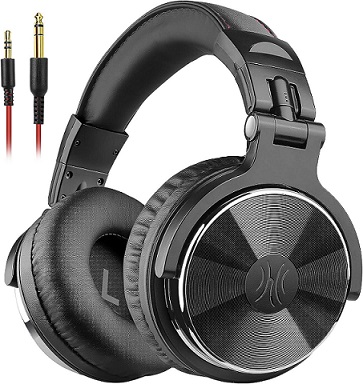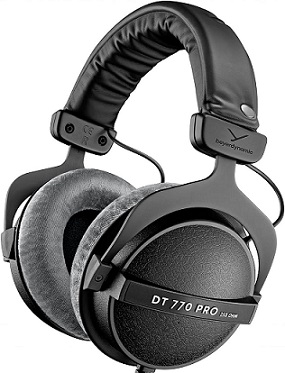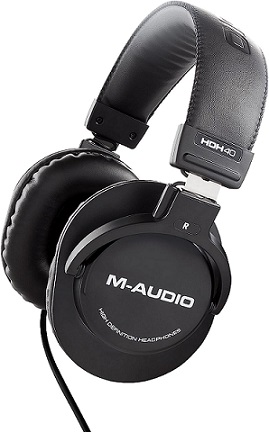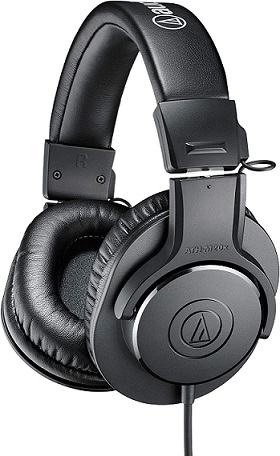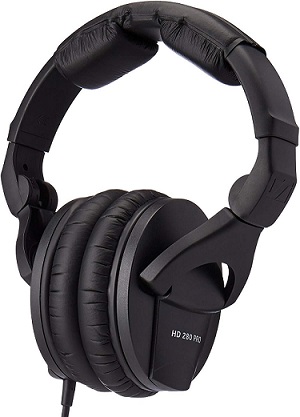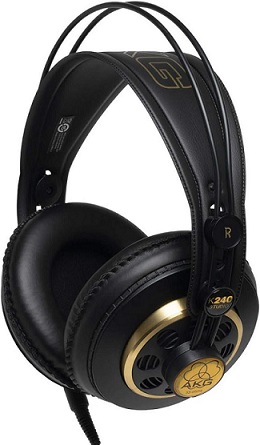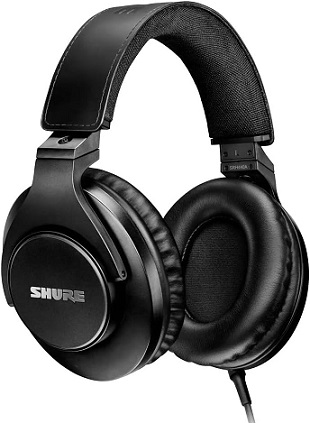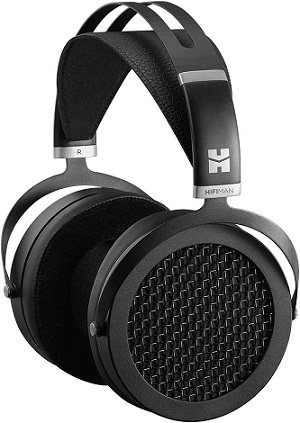Studio headphones for mixing are essential tools for audio professionals, offering accurate sound reproduction and isolation. They provide a flat frequency response for critical listening, enabling producers and engineers to make precise adjustments to mixes. High-quality studio headphones ensure comfort for long sessions and durability for studio use. Whether editing, mixing, or mastering, selecting the right pair can greatly impact the final sound quality of music productions. When choosing studio headphones for mixing, there are a few key features you should keep in mind:
- Type of Headphones: We evaluated both open-back and closed-back models to understand how each type influences sound reproduction and isolation. This differentiation is crucial for determining the appropriate use case, whether it’s for mixing in quiet environments or needing to block out external noise.
- Sound Quality: The cornerstone of our review, sound quality, encompasses accuracy, clarity, and the ability to reproduce a flat frequency response. We looked for headphones that offer a true representation of the audio without coloration, ensuring mixes translate well across different playback systems.
- Comfort and Fit: Recognizing that mixing sessions can extend for hours, we prioritized comfort and fit in our evaluation. Headphones that provide a comfortable fit, adjustable features, and suitable padding are essential for prolonged use without fatigue.
In this article, we’ll review the best studio headphones in 2024 along with detailed “Buying Guide”, based on sound quality, comfort, durability, and other important factors.
Outline
Toggle- Best Studio Headphones For Mixing Table
- Best Studio Headphones For Mixing Reviews
- 1. OneOdio Studio Headphone For Mixing
- 2. Beyerdynamic Studio Headphone For Mixing
- 3. M-Audio Studio Headphone For Mixing
- 4. Audio-Technica Studio Headphone For Mixing
- 5. Sennheiser Studio Headphone For Mixing
- 6. AKG Studio Headphone For Mixing
- 7. Philips Studio Headphone For Mixing
- 8. Samson Studio Headphone For Mixing
- 9. Shure Studio Headphone For Mixing
- 10. HIFIMAN Studio Headphone For Mixing
- Buying Guide For The Best Studio Headphone For Mixing
- Best Studio Headphones For Mixing – FAQs
- Conclusion
Best Studio Headphones For Mixing Table
Best Studio Headphones For Mixing Reviews
1. OneOdio Studio Headphone For Mixing
The first product listed hails from OneOdio, a brand that has garnered impressive reviews across various ecommerce platforms. Making its mark on this list is the Pro-10 studio headphones, renowned for delivering exceptional audio quality at a budget-friendly price point. Equipped with robust 50mm neodymium drivers, these headphones ensure crystal-clear sound reproduction with deep bass, catering perfectly to both professional audio tasks and leisurely listening sessions.
Designed for comfort, these headphones boast plush ear cushions and an adjustable headband, ensuring a snug and comfortable fit even during prolonged use. Additionally, their ear cups can swivel 90 degrees, allowing DJs and musicians the convenience of single-ear monitoring—an invaluable feature for professionals. Apart from this, these headphones are constructed from sturdy materials to withstand everyday wear and tear. Complete with a detachable coiled cable and a convenient carrying case, they are effortlessly portable and secure for on-the-go use.
Best Features
- Type: Closed Back
- Driver Size: 50mm
- Impedance: 32 Ohm
- Frequency Response: 20 Hz – 40K Hz
- Sensitivity: 110 dB ± 3 dB
- Connectivity: 3.5mm,6.5mm adapter
- Cable Length: 3.0m
Pros
- Excellent sound quality for the price
- Comfortable to wear for long periods of time
- 90-degree swiveling ear cups
- Durable construction
- Versatile design for a variety of uses
Cons
- The ear cups can be a bit bulky for some people
2. Beyerdynamic Studio Headphone For Mixing
Beyerdynamic’s DT 770 PRO Studio Headphones stand as a revered choice in professional studios worldwide, lauded for their exceptional sound quality, comfort, and durability. Equipped with high-quality drivers, these over-ear headphones deliver a broad frequency range and powerful bass response, ideal for meticulous audio tasks such as mixing, mastering, and recording. Moreover, their superior noise isolation capability allows users to immerse themselves fully in their audio endeavors.
The headphones are designed with user comfort as a priority, the DT 770 PRO boasts soft, replaceable ear pads and a lightweight, adjustable headband, ensuring prolonged wear remains comfortable. Furthermore, their robust construction is engineered to endure daily usage, promising longevity for years to come.
Best Features
- Type: Closed Back
- Driver Size: Not Mentioned
- Impedance: 250 Ohm
- Frequency Response: 5 Hz – 35K Hz
- Sensitivity: 96 dB
- Connectivity: 3.5mm,6.5mm adapter
- Cable Length: 3.0m
Pros
- Professional-grade studio reference headphones
- Excellent sound quality with wide frequency response and great bass response
- Great noise isolation for focused work
- Comfortable design for long wear
- Durable construction
Cons
- Can be expensive
3. M-Audio Studio Headphone For Mixing
The M-Audio HDH40 Studio Headphones are a great pick for quality-focused individuals needing studio-grade headphones. They come equipped with 40mm neodymium drivers that deliver accurate audio across a wide frequency range, helping you catch every detail in your mixes and recordings. These headphones are built for comfort, featuring soft, closed-back ear cups with faux leather padding and a flexible headband to minimize weariness during long sessions.
What makes the HDH40 headphones stand out is their ability to adapt to various uses, such as studio monitoring, podcasting, and casual listening, compatible with a wide array of devices including smartphones, mixers, and digital pianos. Their frame can rotate 180 degrees for one-ear monitoring, enhancing their flexibility. Though offering excellent sound, comfort, and adaptability at a budget-friendly price, some users might find the non-detachable cable and the potential for less durability compared to premium models a drawback. Still, the M-Audio HDH40 headphones remain an attractive option for those in search of reliable studio headphones.
Best Features
- Type: Closed Back
- Driver Size: 40mm
- Impedance:32 Ohm
- Frequency Response: 15 Hz – 28K Hz
- Sensitivity: 95 dB
- Connectivity: 3.5mm,6.5mm adapter
- Cable Length: 2.7m
Pros
- Excellent sound quality
- Comfortable design for long wear
- Versatile design for a variety of uses
- Affordable price
Cons
- Fixed cable can be inconvenient for some users
4. Audio-Technica Studio Headphone For Mixing
The Audio-Technica ATH-M20x headphones are recommended by our in-house team for those in search of quality sound without breaking the bank. Whether you’re using them in the studio, for casual listening, gaming, or watching movies, these headphones deliver exceptional performance.
They feature 40mm drivers, and produce clear, immersive sound with rich bass, catering to both meticulous music aficionados and professionals who require precision in their studio work. Their design prioritizes comfort, boasting plush ear cups and an adjustable headband to ensure a snug fit during prolonged wear. Additionally, they’re built to last, with a detachable cable for convenient replacement if necessary. Overall, the ATH-M20x headphones offer a winning combination of superior sound quality, comfort, and durability at an affordable price point, making them an adaptable choice for various audio needs.
Best Features
- Type: Closed Back
- Driver Size: Not mentioned
- Impedance: 64 Ohm
- Frequency Response: 8 Hz- 25K Hz
- Sensitivity: 113 dB
- Connectivity: 3.5mm,6.5mm adapter
- Cable Length: 3.0m
Pros
- Excellent sound quality for the price
- Great sound isolation
- Comfortable to wear
- Durable construction with detachable cable
Cons
- Some users have reported that the bass can be too overpowering for certain genres of music
5. Sennheiser Studio Headphone For Mixing
The Sennheiser HD 280 PRO studio headphones distinguish themselves from others on the list with their exceptional comfort. Renowned for their precision and detailed audio delivery, this esteemed brand caters to critical listeners in music and professional audio environments. With the capacity to reproduce deep bass and effectively isolate external noise, these headphones facilitate immersive audio experiences devoid of distractions.
Crafted from durable materials, the HD 280 PRO headphones are engineered for longevity, while their foldable and rotatable design enhances portability and storage convenience. Comfort remains a paramount feature, with plush ear pads and an adjustable headband ensuring a snug fit even during extended use.
Best Features
- Type: Closed Back
- Driver Size: Not Mentioned
- Impedance: 64 Ohm
- Frequency Response: 8 Hz- 25K Hz
- Sensitivity: 113 dB
- Connectivity: 3.5mm,6.5mm adapter
- Cable Length: 2.0m
Pros
- Excellent sound quality with wide frequency response and good bass response
- Great sound isolation
- Durable construction with folding and rotating design
- Comfortable fit with soft ear pads and adjustable headband
Cons
- The cord is long ,coiled and heavy not able to walk or run easily
6. AKG Studio Headphone For Mixing
AKG, a well-known brand in the professional audio industry, offers the K240 STUDIO headphones, which are highly regarded for their sound quality, comfort, and durability. These headphones stand out for their XXL transducers equipped with Varimotion diaphragms, delivering a wide dynamic range and superior frequency response. The result is a natural and precise sound that is perfect for studio activities such as monitoring, mixing, and mastering.
The K240 STUDIO headphones are designed with comfort in mind, featuring circumaural (around-the-ear) ear cups with soft padding and a self-adjusting headband that fits securely without causing discomfort. The headphones are made from durable materials and come with a detachable cable, allowing for easy replacement if necessary.
Best Features
- Type: Open Back
- Driver Size: 30mm
- Impedance: 55 Ohm
- Frequency Response: 15 Hz – 25 kHz
- Sensitivity: 104 dB
- Connectivity: 3.5mm,6.5mm adapter
- Cable Length: 3.0m
Pros
- Excellent sound quality with wide dynamic range and well-balanced mids and highs
- Comfortable design with circumaural ear cups and self-adjusting headband
- Durable construction with detachable cable
Cons
- Semi-open design may not provide enough sound isolation for some users
7. Philips Studio Headphone For Mixing
The Philips SHP9600 Stereo Headphones are equipped with 50mm drivers that are precisely tuned to produce a sound that’s rich in bass, well-balanced in the midrange, and clear in the high frequencies, matching the ear’s natural geometry for detailed audio reproduction.
Their open-back design contributes to a more expansive soundstage, offering an immersive listening experience especially favored by fans of classical, jazz, and acoustic music. Comfort is considered a key feature, with a steel-reinforced headband and ear-cup cushions that are both breathable and soft, making them suitable for long listening periods. These headphones strike a balance between high-quality sound, spacious soundstage, user comfort, and longevity, all while being reasonably priced to appeal to both everyday listeners and serious audiophiles.
Best Features
- Type: Open Back
- Driver Size: 50mm
- Impedance: 32 Ohm
- Frequency Response: 12 Hz – 35 kHz
- Sensitivity: 101 dB
- Connectivity: 3.5mm,6.5mm adapter
- Cable Length: 3.0m
Pros
- Superior sound quality with perfectly tuned 50mm drivers
- Open-back design for a wide and spacious soundstage
- Comfortable design with reinforced headband and breathable ear-cup cushions
- Durable construction with gold-plated cable connections
Cons
- Mic is not present in it
8. Samson Studio Headphone For Mixing
Samson, recognized for its commitment to professional audio equipment for over three decades, offers the SR850 Semi Open-Back Studio Reference Headphones among its acclaimed products. These headphones are favored for their precision in studio environments. Equipped with 50mm drivers, they excel in delivering accurate sound across a wide frequency spectrum, catering to the needs of musicians, producers, and audio engineers.
Designed with extended use in mind, the SR850 headphones feature comfortable cushioning and an adjustable headband, ensuring they can be worn for prolonged periods without causing discomfort. Additionally, these headphones are priced affordably, making them an attractive option for both professionals in the audio industry and consumers seeking high-quality headphones. The Samson SR850 serves well for studio applications or simply for enjoying music, offering a valuable choice for those in search of reliable headphones.
Best Features
- Type: Open Back
- Driver Size: 50mm
- Impedance: 32 Ohm
- Frequency Response: 10 Hz – 30 kHz
- Sensitivity: 98 dB
- Connectivity: 3.5mm,6.5mm adapter
- Cable Length: 2.5m
Pros
- Extended frequency response and great dynamic range
- Circumaural, over-ear design with velour cushioning for outstanding comfort
- Self-adjusting headband for a secure fit
Cons
- Soud can be a bit bright for some listeners
9. Shure Studio Headphone For Mixing
Shure, with over 90 years of experience in the professional audio industry, offers the SRH440A Over-Ear Wired Studio Headphones as one of its standout products. These headphones are celebrated for their superior sound quality, tailored for studio environments where clarity and detail are paramount. They deliver a natural and accurate audio reproduction ideal for a range of applications, including mixing, recording, and everyday listening.
The versatility of the SRH440A headphones means they are compatible with various professional audio devices, making them suitable for podcasting, home recording, or live sound projects. Comfort is also a key feature of these headphones, with a lightweight headband that adjusts for a personalized fit and the ability to fold for convenient portability. Designed with a sleek appearance and durable construction, the over-ear design not only ensures comfort for prolonged use but also aids in isolating external noise, enhancing the listening experience.
Best Features
- Type: Closed Back
- Driver Size: 40mm
- Impedance: 40 Ohm
- Frequency Response: 10 Hz – 22 kHz
- Sensitivity: 97 dB
- Connectivity: 3.5mm,6.5mm adapter
- Cable Length: 3.0m
Pros
- Excellent sound quality with transparent, natural sound signature
- Versatile and compatible with all professional audio devices
- Ultra-comfortable and easy to transport with lightweight headband and collapsible construction
- Sleek and durable design with over-ear, closed-back circumaural design
- Long detachable locking cable
Cons
- Can be a bit tight-fitting for some users
10. HIFIMAN Studio Headphone For Mixing
HIFIMAN is recognized for its innovation in planar magnetic headphone technology, offering high-fidelity audio products. Among its offerings, the HIFIMAN Sundara Over-Ear Full-Size Planar Magnetic HiFi Stereo Wired Headphones are particularly noteworthy for their exceptional sound quality. These headphones employ advanced technology with ultra-thin diaphragms that deliver a broad spectrum of sound frequencies and unparalleled clarity, offering an immersive listening experience akin to a live performance.
The design of these headphones prioritizes comfort, featuring a unique headband that distributes weight evenly, allowing for extended listening sessions without discomfort. They are also built to last, with a construction that can endure the rigors of daily use. Furthermore, these headphones are lightweight and portable, making them an excellent choice for travel or on-the-go listening.
Best Features
- Type: Closed Back
- Driver Size: 40mm
- Impedance: 40 Ohm
- Frequency Response: 10 Hz – 22 kHz
- Sensitivity: 97 dB
- Connectivity: 3.5mm,6.5mm adapter
- Cable Length: 3.0m
Pros
- Stunning sound quality with wide frequency response, fast response, and detailed sound
- Comfortable and durable design with hybrid headband and weight-spreading strap
- Lightweight and portable
- Highly efficient for use with a variety of devices
Cons
- Requires a dedicated headphone amplifier for the best sound quality
Buying Guide For The Best Studio Headphone For Mixing
When selecting the best studio headphones for mixing, it’s essential to consider factors that directly influence your mixing accuracy, listening comfort, and overall sound reproduction quality. Understanding these aspects will help you make a more informed choice that aligns with your specific needs. Here’s a detailed look at the key factors:
1. Type of Headphones
a. Closed-Back
Why It Matters: Closed-back headphones are ideal for recording and mixing in environments where sound isolation is crucial. They prevent sound leakage, which is particularly beneficial when recording vocalists or live instruments, as it stops the backing track from being picked up by the microphone.
What to Look For: Look for models with substantial padding and a secure fit to ensure maximum isolation. Also, consider the headphone’s ability to reproduce bass frequencies accurately, as closed-back designs can sometimes exaggerate lower frequencies.
b. Open-Back
Why It Matters: Open-back headphones are preferred for mixing and mastering due to their ability to provide a more natural and open soundstage. This design allows for better airflow, reducing ear fatigue over long sessions and offering a more accurate representation of how sound will translate in real-world environments.
What to Look For: Focus on models that are known for their wide, accurate soundstage and balanced frequency response. Comfort is also crucial, given the extended periods of use common in mixing sessions.
2. Sound Quality
Why It Matters: The sound quality of studio headphones is paramount, as it impacts your ability to make precise adjustments to the mix. A flat or neutral frequency response ensures that no particular frequency range is exaggerated or diminished, allowing for a more accurate mix that translates well across various playback systems.
What to Look For: Seek out headphones with a reputation for delivering clear, detailed, and balanced sound. Pay close attention to reviews and specifications that mention the headphone’s performance across the entire frequency spectrum, especially in terms of transparency and detail retrieval.
3. Comfort and Fit
Why It Matters: Mixing can be a time-intensive task, often requiring hours of focused listening. Headphones that are uncomfortable or fit poorly can lead to distraction or even physical pain, severely impacting your ability to work effectively.
What to Look For: Look for headphones with adjustable headbands, ample padding, and ear cups that fit well around your ears. Materials matter as well; breathable, lightweight fabrics can significantly enhance comfort during long sessions. Additionally, consider the weight of the headphones, as heavier models can become uncomfortable over time.
4. Durability
Why It Matters: Studio headphones are an investment in your audio production toolkit. Durability ensures that your headphones can withstand the rigors of daily use, including being packed in bags, adjusted frequently, and potentially even dropped. A durable pair of headphones saves you money in the long run by avoiding frequent replacements.
What to Look For: Search for headphones built with high-quality materials. Metal components in the headband and hinges are more robust than plastic. Additionally, look for models that offer replaceable parts, such as ear pads and cables, to extend the lifespan of your headphones.
5. Impedance
Why It Matters: Impedance measures the headphones’ electrical resistance, expressed in ohms (Ω). Headphones with higher impedance require more power to deliver high audio levels, which can result in cleaner sound quality with less distortion. This is particularly important in a studio setting where clarity and detail are paramount.
What to Look For: For studio headphones, a higher impedance (typically around 250Ω or more) is often preferred for use with professional audio equipment that can provide the necessary power. However, if you plan to use the headphones with consumer-grade equipment, such as laptops or smartphones, consider lower impedance headphones (around 32Ω) to ensure compatibility without sacrificing sound quality.
6. Frequency Response
Why It Matters: Frequency response is the range of frequencies that the headphones can reproduce, typically measured in Hz to kHz. A broad frequency response is crucial for mixing as it ensures you can hear the full spectrum of your mix, from the lowest bass to the highest treble.
What to Look For: Look for headphones that offer a wide and flat frequency response. While the exact range can vary, a response from at least 20 Hz to 20 kHz is standard, covering the human hearing range. More important is the flatness of the response, as this indicates how accurately the headphones reproduce each frequency without boosting or cutting any particular range.
7. Sensitivity
Why It Matters: Sensitivity measures how efficiently headphones convert an electrical signal into an audible sound. It directly influences the loudness level headphones can achieve for a given input power. High sensitivity is particularly important in studio environments where precise monitoring of audio details at various volume levels is required.
What to Look For: Sensitivity is usually measured in decibels of sound pressure level per milliwatt (dB SPL/mW). Look for headphones with a sensitivity rating that suits your mixing environment and equipment. A sensitivity rating around 90 to 110 dB SPL/mW is generally adequate for studio use. However, it’s crucial to balance sensitivity with the output capabilities of your audio interface or headphone amplifier to avoid potential hearing damage or distortion at high volumes.
8. Drivers Size
Why It Matters: The size of the headphone drivers plays a crucial role in sound reproduction, particularly in terms of bass response and overall soundstage. Larger drivers are typically capable of producing deeper bass and a more expansive soundstage, which can enhance the accuracy of mixes by providing a clearer representation of the music’s spatial characteristics.
What to Look For: Driver size is measured in millimeters (mm), with sizes commonly ranging from 30mm to 50mm for studio headphones. While larger drivers can offer better bass response, it’s important to consider the overall balance and clarity of the sound. The choice should align with your mixing needs and preferences, as well as the genres of music you work with most frequently.
9. Cable Length
Why It Matters: The length of the headphone cable can affect your mobility and comfort in the studio. A cable that’s too short may limit your movement and force you to stay uncomfortably close to your audio source, while an excessively long cable can lead to tangling and potential signal degradation.
What to Look For: Consider the layout of your workspace and where your audio interface or headphone amp is situated in relation to your usual working position. Studio headphones typically come with cable lengths ranging from 1.2 meters (4 feet) to 3 meters (10 feet) or longer. Some models offer detachable cables with varying lengths for added flexibility. Additionally, look for a cable design that minimizes tangling and offers durability for long-term use.
10. Portability
Why It Matters: Portability is an essential factor for those who mix in different locations or need to carry their equipment between studios, home, and on the road. Lightweight and compact headphones that offer easy storage without compromising sound quality can significantly enhance your flexibility and comfort when working outside a traditional studio setting.
What to Look For: Search for headphones that feature a foldable design, making them easy to pack and transport. Durable construction is also key to withstand the rigors of travel. Additionally, consider models that come with a protective case or bag to safeguard them against bumps and scratches during transit. The presence of a detachable cable is another aspect to look for, as it increases the headphones’ durability and makes them more convenient to store and use on the go.
11. Sound Isolation
Why It Matters: Sound isolation is crucial in preventing external noises from interfering with your mixing process, allowing for more focused and accurate listening. It’s particularly important in noisy environments or when recording live instruments, as it helps to ensure that only the sound coming through the headphones is what you’re evaluating.
What to Look For: For optimal sound isolation, consider closed-back headphones with a circumaural design that fully encloses your ears. The earpad material and the tightness of the fit are also important; memory foam pads can provide a better seal against your head, enhancing isolation. Additionally, some models are specifically designed to offer superior noise cancellation features, either passive or active, which can be beneficial in especially loud environments. Pay attention to the headphones’ specifications regarding their noise reduction capabilities to make an informed decision.
Best Studio Headphones For Mixing – FAQs
Ans: Studio headphones provide a flat, unaltered sound profile, making them ideal for audio professionals. Regular headphones often emphasize bass or treble for a more enjoyable listening experience.
Ans: The choice between open-back, closed-back, or semi-open headphones depends on your soundstage and sound isolation requirements.
Ans: The ideal impedance varies but usually falls between 32 ohms and 600 ohms, depending on your audio source and preferences.
Ans: Yes, you can, but remember that studio headphones prioritize accuracy over enhanced bass or treble, which may be preferred for gaming or casual listening.
Ans: Wireless studio headphones have come a long way, but some professionals still prefer wired headphones for their reliability and audio quality.
Ans: Absolutely, many studio headphones double as great everyday listening devices. It’s all about your personal preference.
Ans: High-end studio headphones are a worthy investment if you demand uncompromising audio quality. They’re often used by professionals who require the best sound fidelity.
Conclusion
The best studio headphones for you will depend on your individual needs and budget.
- If you are looking for a budget-friendly option, the OneOdio Studio Headphone is a great choice.
- If you are looking for a high-quality studio headphone that will last for years, the Beyerdynamic Studio Headphone is a great option.
- If you are looking for an open-back studio headphone with a wide soundstage, the AKG Studio Headphone is a great option.
Explore our top picks, consider your specific needs, and let the music play as it was meant to be heard.

